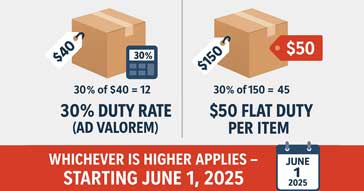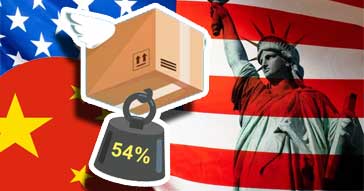⚠️ Update as of April 11, 2025
U.S. tariffs on Chinese imports are changing rapidly. As of April 11, the Trump administration confirmed that the total effective tariff rate on Chinese goods has reached 145%. This includes a recent hike to 125%, combined with an earlier 20% fentanyl-related tariff imposed in February and March. In response, China has increased its own tariffs on U.S. products to 125%, up from 84%, according to the Chinese Ministry of Finance.
Due to these fast-moving developments, some details in this article — such as the 30% or $50 per item tariff — may already be outdated. We recommend keeping an eye on official announcements and trade news for the latest updates.
New U.S. Tariffs on Chinese Packages: Will You Pay 30% or $50 Per Item After May 2, 2025? How Will the 30% or $50 Per Item Tariff Be Applied to Chinese Packages?
Starting May 2, 2025, a major shift in U.S. import policy will hit online shoppers: small packages from China and Hong Kong sent through the international postal network will no longer enjoy duty-free de minimis treatment. Instead, these packages will be hit with a 30% or $25 tariff per item, increasing to $50 per item on June 1, 2025. But how will this actually work in practice?
Let’s break it down, analyze the rules, and explore what it means for consumers, small businesses, and platforms like AliExpress, Temu, and SHEIN.
🔍 What Exactly Is the New Tariff Policy?
According to a White House fact sheet, President Trump’s executive order eliminates duty-free treatment for low-value Chinese imports to combat the flow of illicit opioids and address unfair trade practices. Under this order:
“All relevant postal items containing goods that are sent through the international postal network… are subject to a duty rate of either 30% of their value or $25 per item (increasing to $50 after June 1, 2025).”
This duty applies per postal item, not necessarily per physical item inside a package. The term “item” in this case refers to a postal shipment, not each object in it.
To make the most of your purchases before the new tariffs take effect, consider checking the 2025 AliExpress sales calendar for upcoming deals and discounts.
💡 So, Is It 30% or $50? Which One Applies?
Here’s the key point: the transportation carrier chooses how the tariff is applied—either:
- 30% Ad Valorem Duty — 30% of the declared value of the item (or postal package), or
- Specific Duty — $25 per postal item (increasing to $50 per item after June 1)
But the carrier must use the same method for all shipments, and can only change this method once per month.
In other words, it’s not the buyer who chooses, and it’s not a case-by-case comparison of which is higher. It depends on which collection methodology the carrier selects.
Example:
- If the carrier opts for the 30% method, a $100 item will incur a $30 tariff.
- If the carrier chooses the $50 per item method (after June 1), a $10 gadget will cost you $50 extra, no matter what.
So yes—it can be brutal for cheap items.

Fewer packages = fewer 30%/$50 fees.
📦 Per Item or Per Package?
Many shoppers are confused: Does “per item” mean per product or per parcel?
According to both the Executive Order and interpretations from customs specialists and Reddit users:
“Item” means postal shipment, not individual contents.
So, if you order five cheap items and they all arrive in one postal package, you will likely pay one tariff, not five. But if each item is shipped separately—as is often the case with sites like AliExpress—you could be hit multiple times.
🤔 What This Means for AliExpress Shoppers
Platforms like AliExpress and Temu often ship low-cost goods individually to keep processing simple and take advantage of de minimis rules. This policy change flips that model on its head.
Shoppers may start to:
- Avoid cheap, single-item purchases from China
- Demand consolidated shipments to pay fewer tariffs
- Turn to local or U.S.-based warehouses where possible
- Split purchases by value or type depending on the carrier’s method
Expect platforms to adjust their logistics, possibly by bundling multiple items into one shipment or routing through non-postal carriers—but this takes time.
💬 What Are People Saying?
Reddit users and online communities are buzzing:
“So all this means is the more bougie people will lump their purchases into $150 orders and the low income peeps will just replace the items they use with smog infested air.”
“You better make sure that you fit as much as possible into one package when ordering.”
Others speculate that this policy might backfire by increasing the price of everything, including goods sold on Amazon, which often source directly from China.
🚨 TL;DR — Key Takeaways
- Starting May 2, 2025, packages from China and Hong Kong sent via postal service will be subject to tariffs.
- Carriers can choose between charging 30% of the value or a flat fee per postal item ($25 → $50).
- “Per item” = per postal package, not per product inside.
- Shoppers should consolidate orders and stay informed on carrier methods.
- Expect AliExpress and other platforms to adjust shipping strategies.
🛒 Final Thought
Prepare for the worst, hope for the best.
The new 30% or $50 per item tariff is a wake-up call for budget-conscious consumers and a challenge for global e-commerce. Whether this leads to better trade balance or simply more expensive watch straps remains to be seen—but one thing is clear: May 2 will change online shopping as we know it.
Disclaimer: This article is for informational purposes only and does not constitute legal or financial advice. Readers should consult official government sources or a qualified customs broker for the most up-to-date and accurate information regarding tariffs, import regulations, and shipping policies.

